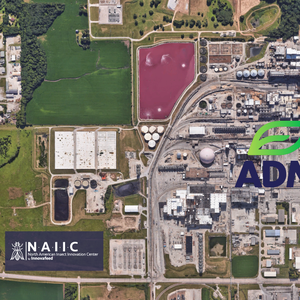USDA announced today that DNA evidence now helps to verify -- with a high degree of certainty -- that the BSE positive cow found in Washington State originated from a dairy farm in Alberta, Canada. This DNA evidence is based on a comparison of DNA from the brain of the positive cow with the DNA from semen of her sire and was confirmed by both U.S. and Canadian animal health laboratories.
Additional DNA testing continues at this time involving the heifer calf on the index farm which was born from this positive cow. Breeding records on that calf confirm that the animal was born from the cow bearing the tag number found at slaughter and found in the records on the farm in Alberta.
This new DNA information, coupled with the documentation that USDA has obtained from its colleagues in Canada, the owner of the dairy farm in Mabton, Washington, and from import records, further increases USDA's confidence in the accuracy of this traceback.
Other elements of the investigation continue on both sides of the border and may provide additional information. This includes the cattle feed investigation in Canada as well as the additional DNA testing.
As a point of clarification, on USDA's technical briefing call this afternoon in conjunction with the Canadian Food Inspection Agency, Canada's Chief Veterinary Officer, Dr. Brian Evans, commented that 17 young stock from the BSE-infected animal's birth herd also arrived in the United States as part of a later shipment. USDA and Canadian officials are currently working to confirm if any or all of these 17 animals -- all heifers -- did in fact enter the United States.
In another important development, USDA personnel began the process of depopulating the bull calf operation outside Sunnyside, Washington, this morning. Approximately 450 calves have been transported from the farm to a designated slaughter facility to be euthanized according to American Veterinary Medical Association guidelines.
On December 23, 2003, USDA's Food Safety and Inspection Service (FSIS) issued a Class II recall of approximately 10,410 pounds of raw beef that may have been exposed to tissues containing the infectious agent that causes BSE. FSIS' designation of the recall as Class II was due to the extremely low likelihood that the beef contained the infectious agent that causes BSE. According to scientific evidence, the tissues of highest infectivity are the brain, spinal cord, and distal ileum. All were removed from the rest of the carcass at slaughter. Therefore, the meat produced were cuts that would not be expected to be infected or have an adverse public health impact. The recall is being conducted out of an abundance of caution.
* FSIS is continuing its around the clock investigation and has determined the points of distribution for all of the recalled product.
* All of the primary, secondary and tertiary establishments that may have received product subject to this recall have been contacted by
FSIS compliance officers. All have acknowledged being contacted about the recall by their suppliers. All have confirmed securing
whatever product they had upon notification of the recall and making their customers aware of the recall as well.
* FSIS will now focus its efforts toward verifying the return and destruction of the recalled products.
* Recall effectiveness checks have determined that product was sent to six states. Those states are Washington, Oregon, California, Nevada, Idaho and Montana. Alaska, Hawaii and Guam did not receive any of the products subject to recall.
USDA has begun implementation of a verifiable system of national animal identification. The development of such a system has been under way for more than a year, although some in the industry had opposed it.
USDA's Food Safety Inspection Service (FSIS) will also take the following actions in several areas:
• Downer animals — Effectively immediately, USDA will ban all downer cattle from the human food chain and will continue its BSE surveillance program. A "downer" cow is one that is not ambulatory for any reason.
• Product holding — USDA FSIS inspectors will no longer mark cattle tested under the BSE surveillance program as "inspected and passed" until confirmation is received that the animals have, in fact, tested negative for BSE. This new policy will be in the form of an interpretive rule that will be published in the Federal Register.
• Specified risk material — Effective immediately upon publication in the Federal Register, USDA will declare as specified risk materials the skull, brain, trigeminal ganglia, eyes, vertebral column, spinal cord and dorsal root ganglia of cattle over 30 months of age and the small intestine of cattle of all ages, thus prohibiting their use in the human food supply. Tonsils from all cattle are already considered inedible and therefore do not enter the food supply. These enhancements are consistent with the actions taken by Canada after the discovery of BSE in May, USDA said.
In an interim final rule, FSIS will require federally inspected establishments that slaughter cattle to develop, implement, and maintain procedures to remove, segregate and dispose of these specified risk materials so that they cannot enter the food chain. Plants must also make that information readily available for review by FSIS inspection personnel.
FSIS has also developed procedures for verifying the approximate age of cattle that are slaughtered in official establishments. State inspected plants must have equivalent procedures in place.
• Advanced meat recovery — AMR is an industrial technology that removes muscle tissue from the bone of beef carcasses under high pressure without incorporating bone material when operated properly. AMR product can be labeled as "meat." FSIS has previously had regulations in place that prohibit spinal cord from being included in products labeled as "meat."
The new regulation, effective upon publication in the Federal Register, expands that prohibition to include dorsal root ganglia, which are clusters of nerve cells connected to the spinal cord along the vertebrae column, in addition to spinal cord tissue. Like spinal cord, the dorsal root ganglia may also contain BSE infectivity if the animal is infected.
In addition, because the vertebral column and skull in cattle 30 months and older will be considered inedible, it cannot be used for AMR.
In March 2003, FSIS began a routine regulatory sampling program for beef produced from AMR systems to ensure that spinal cord tissue is not present in this product. In a new interim final rule announced today, establishments have to ensure process control through verification testing to ensure that neither spinal cord nor dorsal root ganglia is present in the product.
• Air-injection stunning — To ensure that portions of the brain are not dislocated into the tissues of the carcass as a consequence of humanely stunning cattle during the slaughter process, FSIS is issuing a regulation to ban the practice of air-injection stunning.
• Mechanically separated meat — USDA will prohibit use of mechanically separated meat in human food.
USDA on Dec. 23 said it had tentatively diagnosed BSE in a downer cow in Washington state. That diagnosis was later confirmed by a laboratory in the United Kingdom.
The cow was slaughtered on Dec. 9, and its meat was distributed into the U.S. food chain, primarily in states in the western U.S. and Guam. The situation has led to a widespread ban by other countries on U.S. meat exports and numerous calls within the U.S. for tighter USDA controls over meat processing and the food system.










